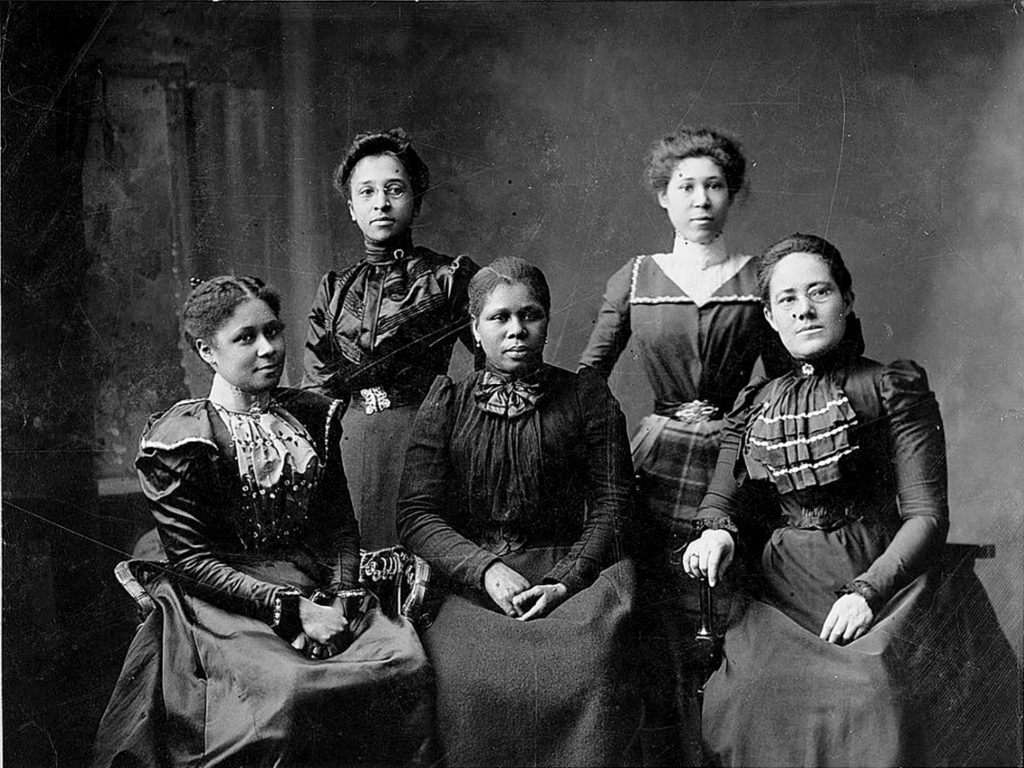Missing from the pages of our history books
The first US gathering for women’s rights was convened in Seneca Falls, NY, by leaders of the anti-slavery movement. The “Declaration of Rights and Sentiments” signed by participants benefited from the gathering’s exposure to the Iroquois nation, where women enjoyed social equality and independent authority within their community. Frederick Douglass, a black activist leader attended the convention and leant his powerful voice in support of the Declaration. Protest parades in front of the White House were led by, among others, a Native American girl and a Chinese Immigrant.

The movement for women’s rights, including the right to vote, thus owes its accomplishments to more than the white women leaders we are familiar with from the history books.
In the late 1800s, black women formed clubs and organizations where they could focus on a particular set of objectives. As daughters of slaves, they saw enfranchisement as a way to be recognized as citizens and as a means to elevate their communities. Because of their unique position, Black women tended to focus on human rights and universal suffrage, rather than suffrage only for African Americans or for women.
Some of the women of color who made a difference include:
Mary Shadd Cary (1823 – 1893) was a journalist, teacher, lawyer, politician and the first African American to form an association – Colored Women’s Progressive Franchise Association. Its purpose was both political and economic. She was the first woman to attend Howard University Law School in 1880 but did not graduate because DC code wouldn’t admit women to the Bar. A decade later, she received a degree. She proposed an amendment to strike the word “male” from the Constitution.
Hallie Quinn Brown (1849 – 1949) was an activist, delivering the suffrage message to black churches, anti-slavery societies, and women’s groups. She toured with antislavery lecturers, including Lucretia Mott and Lucy Stone. She continued to fight for the right to vote even after passage of the 19th Amendment as Jim Crow laws disenfranchised black men and women throughout the South.
Ida B. Wells Barnett (1862 – 1931) was a teacher, journalist, and activist who refused to give up a purchased seat and sued the railroad. Articles on anti-lynching exposed injustices of the Jim Crow law in the South, including disenfranchisement, segregation, lack of education and economic opportunities. Barnett refused to move to the back of the 1913 suffrage parade, marching along with 5000 other women up Pennsylvania Avenue.
Mary Church Terrell (1863 – 1954) was an educator, author, lecturer, and activist who learned about women’s rights and Susan B. Anthony’s suffrage campaign while attending Oberlin College. She established the National Association of Colored Women, acting as its first President, and later became a member of the NAACP. She spoke of the double burden of blackness and womanhood.
Zitkala-Sa (Red Bird) (1876 – 1938) was a writer, teacher, and political activist. She wrote about Native American life, culture, and loss of identity, fought racial stereotypes, and led the Council of American Indians to unite tribes and gain suffrage for all.
Adelina Otero-Warren (1881 – 1965) was an educator and politician in New Mexico. Otero-Warren helped Alice Paul organize the Congressional Union for Woman Suffrage, and after the 19th Amendment allowed women to vote, she ran for congress as a Republican.
She belonged to the Votes for Women’s Club in the city of Los Angeles which was active in 1910 and in 1911. She served as the president of the College Equal Suffrage League and was a respected orator who worked as a translator to help the California suffrage campaign.
Maria Guadalupe Evangelina Lopez (1881 – 1977) Lopez was active in the Votes for Women club In Los Angeles and served as president of the College Equal Suffrage League. She worked as a translator for the California suffrage campaign and was responsible for 100,000 dual language voter pamphlets. She was one of the first women to give a speech in Spanish in support of women.
Clara Elizabeth Chan Lee (1886 – 1993) After California passed Proposition 4, Lee was the First Chinese American to register to vote in the US in 1911, nine years before the passage of the 19th Amendment. As a founder of the Chinese Women’s Jeleab (self reliance) Association in 1913, she promoted women’s rights in both the US and China.
“Lifting as we climb”
The motto of the National Association of Women’s Clubs was “Lifting as we climb.” Hallie Quinn Brown commented: “I believe there are as great possibilities for women as there are in men … We want a grand and noble womanhood, scattered all over the land. There is a great vanguard of scholars and teachers of our sex who are at the head of institutions of learning all over the country. We need teachers, lecturers of force and character to help teach this great nation of women.”
Those words were true then and are true now. Only if we “lift others as we climb” will we help to ensure rights and respect for everyone.
Carolyn Woodling is active in the League of Women Voters, NOW and the Zonta Club of South Puget Sound.

Check out this book:
Miss Forten Of Philadelphia: Awesome Black Female Educator and Fanny Marion Jackson Coppin: First Black Female Principal, both by local author LaWanda Johnson.
Be First to Comment